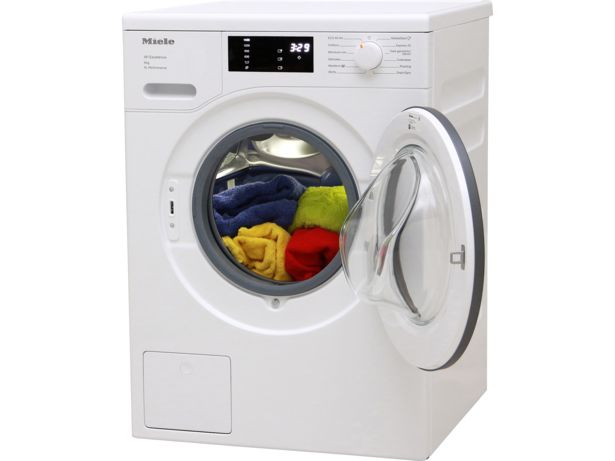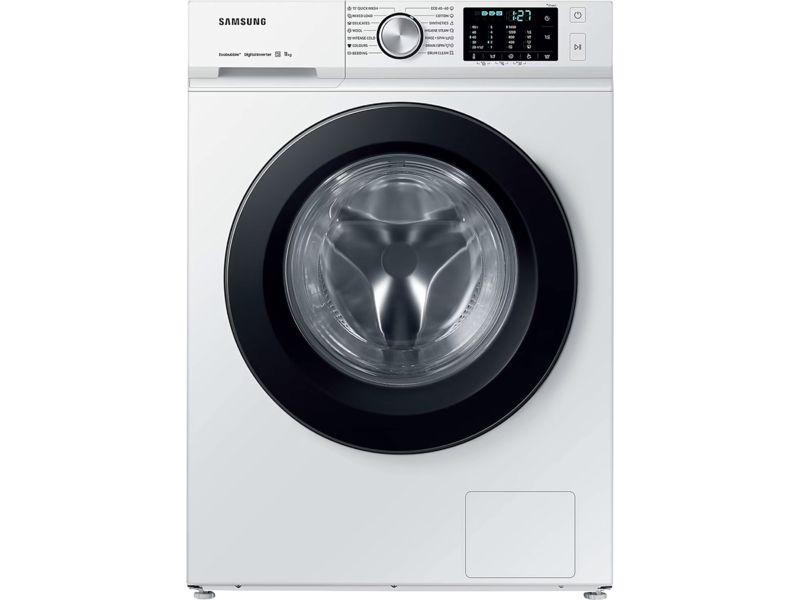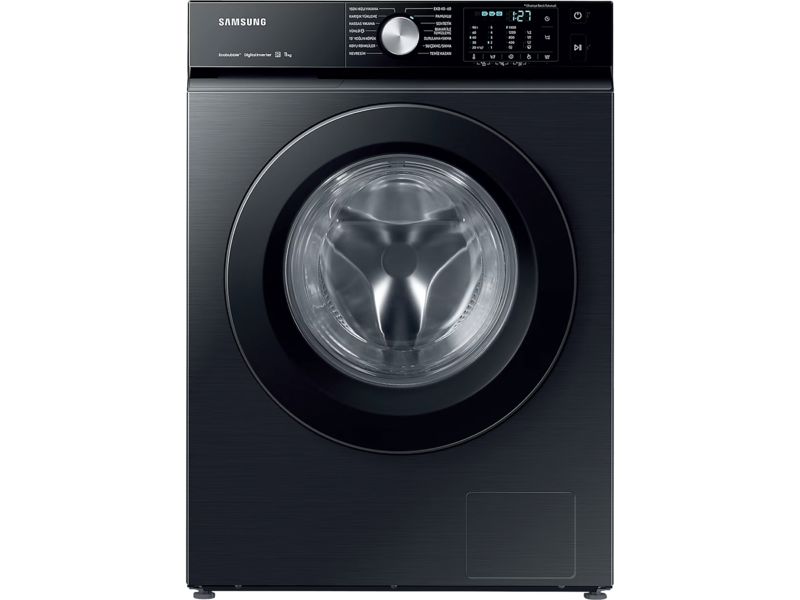How to install a washing machine

In this article
- How to install a washing machine
- Switch off and unplug your old washing machine
- Switch off the cold water supply isolating valve
- Unscrew the cold water-in pipe
- Pull out the waste-water hose
- Remove carriage bolts from your new washing machine
- Attach the cold water-in hose
- Turn on water-in isolating valve
Save money on your new washing machine by doing the installation yourself.
Given the size, weight and general bulkiness of a washing machine, this isn’t going to be a job for everyone. But if you’re able to move a heavy white box around, and don’t mind getting your hands dirty, this is a useful way to save over £25 in installations costs for a freestanding washing machine and around £100 for a built-in or integrated model.
If you’re still searching for the right washing machine to install in your home, check out the 200+ washing machine reviews on our site to find the best model for you.
Be inspired to make home improvements. Sign up for our Home newsletter – it's free monthly
How to install a washing machine
You'll need:
- Mole grips (or mole wrench)
- Bucket
- Spirit level
Use our tool below and answer the questions to help you through each step of the way.
Switch off and unplug your old washing machine
Before you disconnect your washing machine, remember to empty it of any clothes that may be in the drum, switch it off at the mains and unplug it.
Switch off the cold water supply isolating valve
Pull your machine away from the wall and then switch off the isolating valve on the cold water supply. This will usually be a small blue tap.
Unscrew the cold water-in pipe
The cold water supply will attach to your mains water via a hose that is attached to the top of the back of your machine.
Check that the cold water supply is switched off and unscrew the cold water-in pipe. Have a bucket or tray handy to catch any water from the hose. Water from the cold water supply will now be switched off, so there should only be drips coming through that one.
Pull out the waste-water hose
You’ll see another hose that’s going from your washing machine into your kitchen floor. That’s the waste-water hose. To disconnect this you simply need to pull it out.
Now your old washing machine is disconnected from the electricity, has had the cold water in isolating valve isolated, and has both its cold water and waste supplies disconnected, you’ll be ready to move it out of the way and connect your new machine.

Remove carriage bolts from your new washing machine
Bolts are attached to the back of washing machines which will need to be removed before you install and start using it. The bolts are designed to secure the drum from moving around and potentially getting damaged while the machine is in transit.
The bolts are screws attached to plugs which, while they’re in place, press against the drum to secure it. There will usually be four bolts and all of them will need to be removed.
Removing them is an easy job, just unscrew them and once loose, they can be removed easily.

Attach the cold water-in hose
The hoses you’ll need to install your new washing machine are often found inside the drum of the machine, so open the door to find the parts you’ll need.
Screw the cold water-in pipe to the attachment at the top of the back of the machine. Use mole grips to do this (for the DIY novices, this looks like the more heavyweight brother of a spanner and is also known as a mole wrench, vice grips or vice pliers). As you do this, you’ll see a filter inside the attachment. Bear this in mind as something to check should your machine ever stop working in future; the filter can be unscrewed and washed under the tap.
The other end of the water-in hose attaches to your cold water supply and again can be screwed into place.
Turn on water-in isolating valve
Once the cold water supply hose has been attached to the washing machine, release the isolating valve to allow water to flow though the pipe. Once the water is released, check whether everything has been sufficiently fastened by looking for any dripping leaks.

Attach waste water hose
The waste water hose will come attached to your washing machine and will just need to be manually fed into the waste water down pipe.
Many machines will come with a plastic U-bend that you can attach the hose to. Rigid U-bends like this are useful as they help maintain the shape of the hose and avoid blockages building-up in a kinked hose. You can attach the U-bend to the wall, but remember this when you pull the machine out in future.
Now you can push your washing machine back into place.

Level your washing machine
You’ll need to make sure that your washing machine is level before you start to use it. This is important as the machine could be spinning at speeds of up to 1,600rpm and an unbalanced washing machine will cause unwanted vibration, noise and could end up damaging the machine and reducing its lifespan.
Once your machine is in its final position, use a spirit level to see if it’s level. If you don’t have one to hand, hold the machine in either corner and try to rock it back and forth gently.
If it moves or if the spirit level shows that it isn't level, you’ll need to adjust the legs at the front of the machine to make it stable. You might be able to do part of this job by hand, but keep a spanner handy, too.
You’ll need to loosen the locking nut, which locks the legs in position and once this is loose, use the spanner on the legs to raise or lower the machine. Check that your machine is level with the spirit level and then tighten the locking nut against the underside of the machine to make sure the machine’s legs stay at the height you’ve set.
You’re ready to start washing your clothes
With the machine unpacked, the carriage bolts removed, water-in attached and waste water flowing away to the drain and the machine nicely level on your floor, your machine is now installed and ready to start washing clothes.
Double check the depth of your new washing machine
If you already have a washing machine installed and you’re buying a new one, you might think that any machine will easily fit in the space.
But although washing machines are usually around the same height and width, you’ll find differences in depth measurements.
Machines with larger drums and wash capacities tend to be a few centimetres deeper than smaller capacity machines.
When ordering your new washing machine, allow for 7cm on top of the depth of your machine to make sure that you can safely accommodate your waste pipe and water inlet pipes.
Washing machine measurements to check before you install
Installation costs compared: how much could I save?
The costs involved in connecting a new washing machine vary from shop to shop, but wherever you go you’ll be charged. We’ve looked at the prices charged by four leading washing machine stores for both freestanding and built-in models.
AO washing machine installation costs
Installing a new washing machine costs £30 at AO and it’s another £25 to remove and recycle your old machine.
Argos washing machine installation costs
Installation and recycling (with no disconnection) for washing machines cost £50 at Argos.
Currys washing machine installation costs
It costs £30 to have Currys install a washing machine purchased from them. The price for recycling old models is £25.
John Lewis washing machine installation costs
Connection with installation costs £25 for washing machines purchased from John Lewis. It charges another £20 per appliance to recycle your old machine.
Integrated washing machines cost more to connect
Integrated or built-in appliances cost more to install as a kitchen cabinet door needs to be attached to the appliance door. The kickboard in your kitchen will also need to be removed to install the machine.
Argos charges £140 for disconnection, installation and recycling of an integrated washing machine, or £19.99 just to recycle your old machine. Currys (£115) and John Lewis (£90) also handle integrated appliance installations, charging from £20 to remove and dispose of your old appliance. AO charges £115 to install the new washing machine, which includes disconnection of the old product.
Prices were last checked in February 2024.
Read our guide to the best integrated washing machines for advice on how to measure for an integrated model



